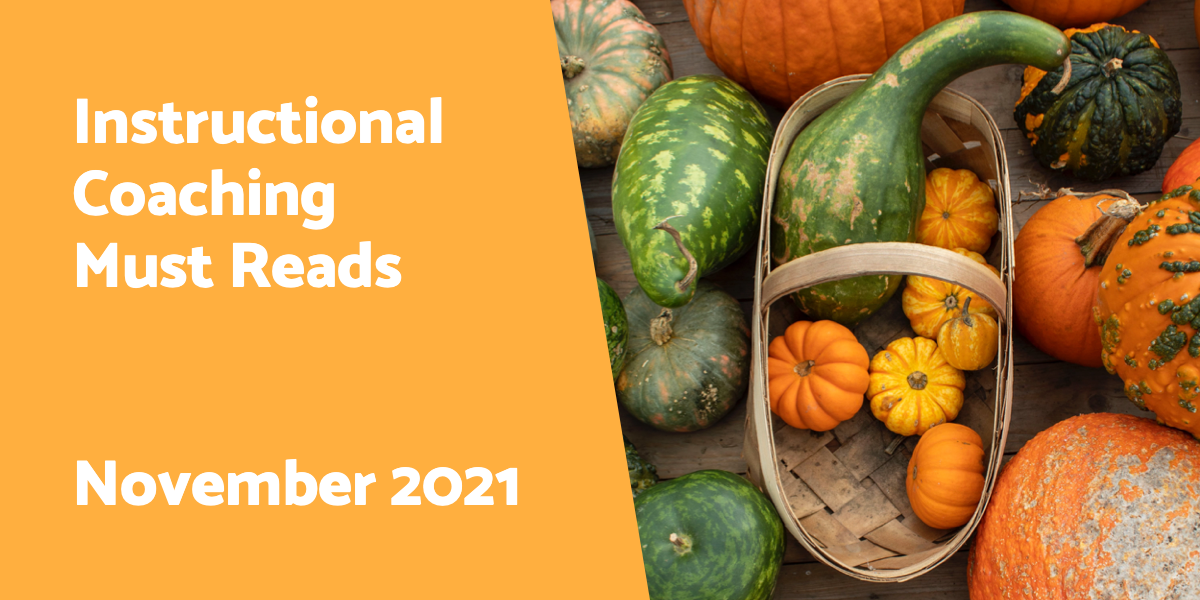


We’re thankful for the healthy serving of coaching articles that November’s Weekly Coaching Roundups supplied. Read on to learn how to help overwhelmed teachers, a few fun strategies to re-energize your PLCs, five steps for planning and designing professional development sessions, how to build your confidence as a coach, and more!
Join our weekly coaching roundup to get articles like these sent directly to your inbox every week and never miss the latest coaching news, tips, or tools!
The Secret to Re-Energizing PLCs
Traditional PLCs are often dull and leave educators feeling like they’re another task to do in their already busy schedules. Casey Watts offers a few fun strategies that re-shift the focus of your current PLCs to be ones focused on a shared culture of collaboration.
“We are in meetings all the time!
What’s important to maintain is the belief that every conversation matters; therefore, every meeting matters. And
if the meeting doesn’t seem to matter, begin to question how you can make it matter. Strategically facilitating meetings can make them matter, thus promoting that collaborative culture we desire. Treat every meeting as though it’s meant to be collaborative.”
How Not to Be One More Thing
Chrissy Beltran covers four methods ICs can exercise to show overwhelmed teachers that they are problem-solvers, not just their coach.
“Many times, teachers get stuck in their bubble and all they can see is their issues. As an instructional coach,
you can show them another path and give them new ideas because you have the experience of seeing other classes. You have the benefit and freedom to
think beyond individual challenges to see the big picture. This is what many teachers need to gain perspective and finally solve their problems.”
Parallel Practice for Social-Emotional Learning
For teachers to take care of students, they must first be at one with their own emotions. Morgan Davis highlights four of her go-to practices that prioritize her teachers social-emotional and physical well-being.
”
Teachers should anticipate a question about their self-care during our professional development sessions, our PLCs, and our coaching conversations. . . . With any change—
no matter how small—we should take time to name our emotions, which both normalizes and validates them.”
5 Steps for Planning and Designing Professional Development
Are you struggling with where to begin as you prep your next professional development session? Latoya Reed walks through her step-by-step guide for creating targeted PD and how to avoid roadblocks that may come your way.
”
Self-reflection about your preparation and delivery will aid in your continuous improvement in your coaching work. . . . After your successful PD session, it’s reflection time! Ensure that you
make time for your participants to reflect and provide feedback on the session, which gives you some solid data on how the presentation went and how you can improve it in the future.”
Apply to Pilot TeachBoost Coach!
TeachBoost Coach is the first technology platform to manage coaching cycles, goals, meetings, & evidence. It works on any device—so you’ll never miss an important moment with a teacher. Sign up below to try us out today!
{{cta(‘6d320956-4380-405e-8e93-06ed341bdca2’)}}
Data Rules
Jim Knight believes there are six foundational rules ICs and teachers should adhere to when collecting and working with data.
“Teachers are best motivated, and consequently learn the most, when they choose data gathered during coaching. This doesn’t mean that a coach can’t suggest types of data to be collected. But in some cases teachers won’t know what data to gather and, therefore, need suggestions from their coach.
Effective coaches master the art of suggesting types of data while still positioning the teacher as the decision maker in the conversation.”
Just Show Up: Building Confidence as a New Instructional Coach
Trusting yourself is critical in a coaching role filled with victories, roadblocks, and everything in-between. Monica Carpenter reflects on nine lessons she learned to build confidence during her first year on the job.
”
Being authentic and vulnerable gains you the respect and trust of those teachers you are working with. Whether you are young or old, experienced or inexperienced, you were hired for this role for a reason. Your organization read your resume, knew your experience, and believed you have the ability to bring something unique to their school. So bring all of you to the table: walk in that confidence, take up space, and be you!”
The Conversation Workout
Jim Knight is back with his research-backed, four-step plan that helps you become a better communicator.
“Just like working out in a gym,
a conversation workout involves committing to a plan, learning new skills, and then practicing and getting feedback until we become proficient at those skills. . . . Pick one idea and practice it until you become proficient, then move on to something else.”
A Sustainability Strategy for New Teachers
Lina Darwich and Alisun Thompson overview their “3 Rs to Remember” strategy that helps with teacher retention and stress.
“It’s important to be aware of how rituals can help with our renewal, so our goal is for pre-service teachers to
become intentional about carving out time for activities that they want to make into restorative rituals as they become teachers. . . . Without consistency, we can’t identify their role in strengthening and renewal.”
{{cta(’34b13594-505a-497a-8a75-16ae35acf14d’)}}
Have some interesting instructional coaching news?
Share it with TeachBoost and we’ll highlight it here.
Photo by Cassandra Lyon from Unsplash.
Stay Connected
News, articles, and tips for meeting your district's goals - delivered to your inbox.








